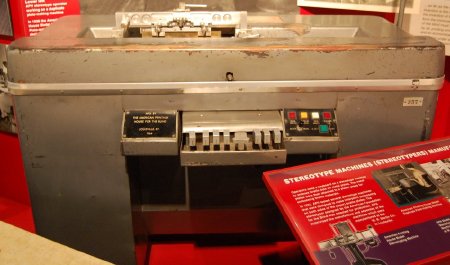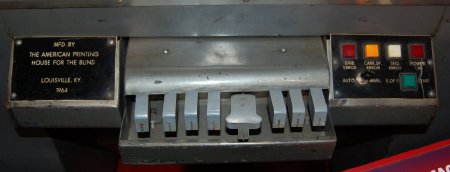Object ID:
1992.265
Title:
Stereotype Machine
Description:
Console model electronic stereotype machine; gray enameled tinplate chassis on four legs with opening in front for operator's legs; top cover is gray enameled plastic shell with aluminum trim; eight-plastic-key keyboard mounted to front, flanked by two boxes; on left box plate reads "Mfd. By The American Printing House for the Blind, Louisville, KY, 1964."; right box is control panel with five colored momentary switches and a manual/automatic toggle; tag with serial number "357" on front right; recess in top cover reveals rectangular bright aluminum "rack" which secures brass stereograph sheet metal during embossing.
Dimensions:
H-37 W-45 D-21.25 inches
Date:
1964
Made by:
American Printing House for the Blind
Place of Origin:
Louisville, KY
Provenance:
In 1957 APH began a research project with IBM to produce braille using computer technology. The system was fully operative by the fall of 1964. An operator typed text onto key-punch computer cards (or later onto special computer tapes). By 1972, APH had 22 key-punch operators on staff. The cards were fed into an IBM computer (first a 709, later a 7040) which transcribed the braille and produced braille and English texts side by side for ease of proofreading. After corrections were made, the cards were fed into an electronic stereotype machine, developed at APH, which stamped the braille on zinc embossing plates. The operation eliminated manual stereotype machines. It reduced the translation of a 300-page book from six days of work by a skilled braille translator to one hour by an ordinary key-punch operator. Could read cards or tape. Sold by special order, mostly overseas.
Credit Line:
APH Collection, 1992.265.

